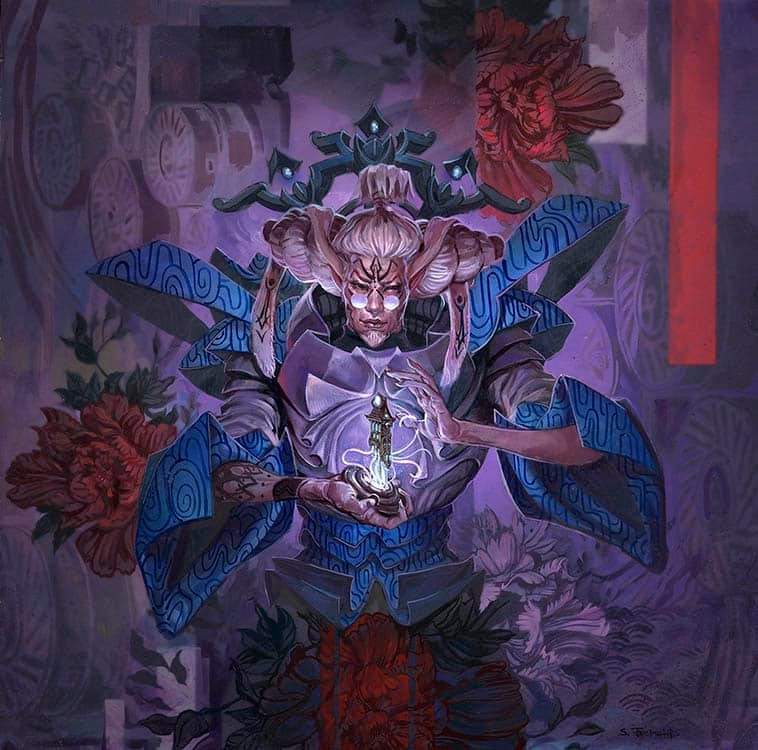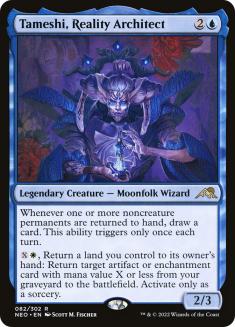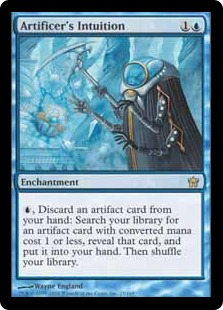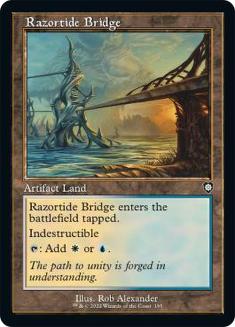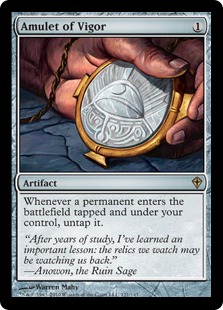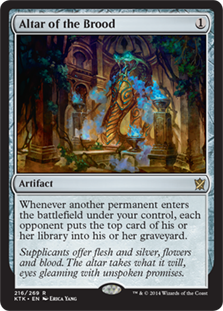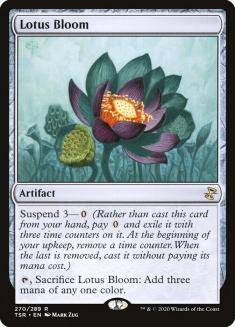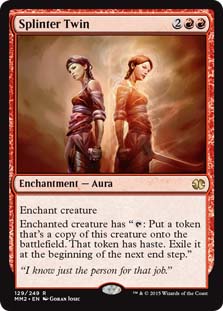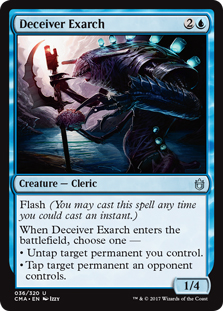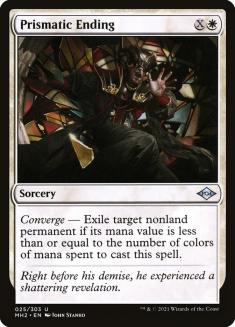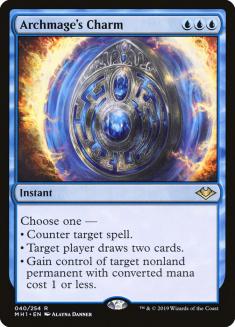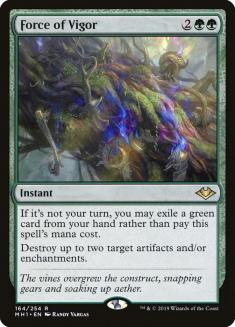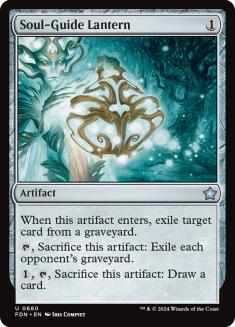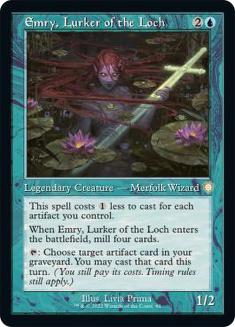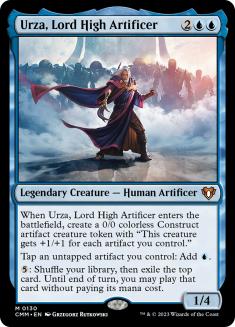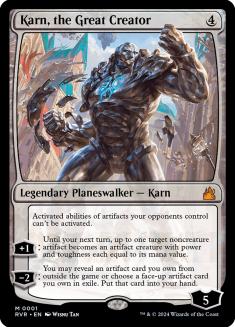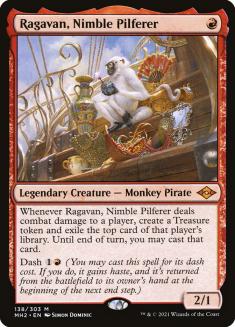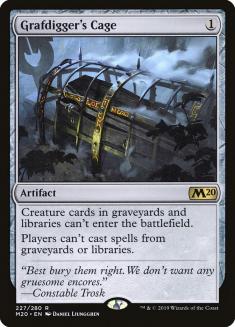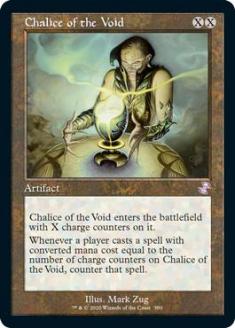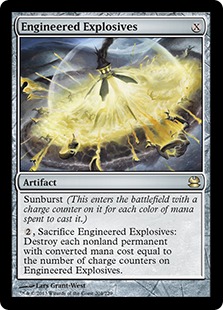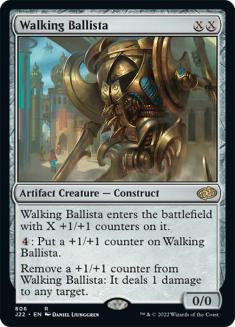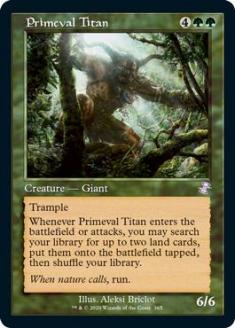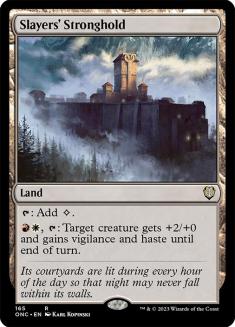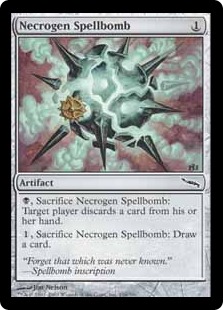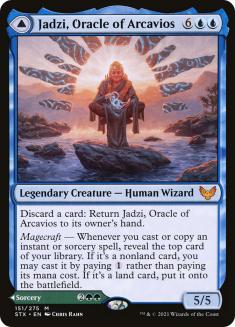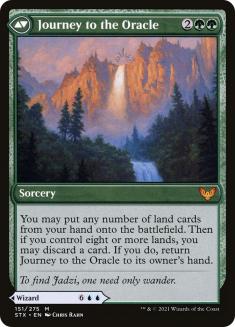I’ve been hyped up for Tameshi, Reality Architect in Modern. Or what’s the word for when you’re hyping something a lot but also hedging it every time? Low-key hyping?
The card has a lot of really good words on it. I vaguely knew what the end-game was (looping artifact lands with Altar of the Brood and a discard outlet). I vaguely knew what the start of the chain was (Lotus Bloom). But I had no idea the specifics or how to get from vaguely Point A to vaguely Point B.
But the mad man did it. Dom Harvey outlined the actual way to combo off with Tameshi in Modern, and it is so easy that I literally had to finish building the deck he outlined.
That’s it. Artificer’s Intuition, fiddle a bit, Tameshi. GG, you win.
Eventually, every Survival of the Fittest variant will end up going the same way. When you get to tutor an arbitrary number of times, you’re going to get some sort of combo that probably uses the graveyard. People have been trying with Artificer’s Intuition for almost twenty years, and it’s about time they got paid off for it.
Dom laid out the basics of the loop last week, but to reiterate the end-game once you assemble Tameshi plus Artificer’s Intuition:
Two Amulet of Vigor, Altar of the Brood, a Razortide Bridge in graveyard, a Razortide Bridge on the battlefield, a white mana.
Bounce a Bridge to recur a Bridge, using the white mana. Double Amulet of Vigor gives you two Razortide Bridge activations for a blue and a white. Use the blue to discard the just-bounced Razortide Bridge, and you’re back to the start of the loop with an extra Altar of the Brood trigger and an Artificer’s Intuition search. A third Amulet of Vigor would mean infinite mana, which, if you don’t have the Altar of the Brood already, lets you find and cast it off your infinite Artificer’s Intuition searches.
The part where Dom hand-waved a little was in the setup stages. There was a vague “loop Lotus Bloom a bunch, and Artificer’s Intuition a lot, then activate Tameshi a few times,” but this is some deterministic stuff. The boundary conditions of your combo kill should be well-defined, because knowing whether the Turn 2 Artificer’s Intuition, Turn 3 activate it some, Turn 4 Tameshi setup is a clean kill or requires more pieces defines whether you build a more controlling deck. Or maybe you need to cast some of the Amulet of Vigors from hand, which means you need more artifacts in deck to filter to them. Or maybe all the Artificer’s Intuition activations on Turn 3 matter, which implies a deck with a lot of blue mana.
Assuming I did the math right, I believe the answer is that the constraints are there, but not huge.
From four lands and Lotus Bloom in graveyard, you cast Tameshi and activate it to recur Lotus Bloom (three lands left). Lotus Bloom makes white. Then you recur Bloom again and make blue (two lands, two white, three blue). You recur one Amulet of Vigor from graveyard, then cast one from hand that’s presumably the end of your Intuition chain (one land, one white, one blue). Recur a Razortide Bridge, and if you have another Bridge in hand or graveyard, you’re at the start of the combo with a blue mana left over to cast Altar of the Brood when you find it. Or you can cast another Amulet of Vigor from hand with that blue to start for the same effect.
It looks like the constraint is not lands on Turn 4 or any mana, but actually assembling the cards. They’re relatively agnostic about what zone they are in, but if you look at that starting curve, you need five specific cards to be places and only have up to three blue mana on Turn 3 to Intuition with. There’s a lot of complicated math or simulation you could do here to get a precise answer on how likely that is, but we can skip most of that by realizing this is another conditional on top of drawing two specific cards.
You can certainly threaten a Turn 4 kill, but this is a Splinter Twin situation. As in, the base combo isn’t reliable enough, but just putting the cards in your deck isn’t bad and you can combo-control people right out of the metagame.
Honestly, this plays right into one of the guiding principles of 2022 Modern, driven largely by the answers baked into both Modern Horizons sets.
If you’re playing a linear, combo-style deck, you need to really pick a land. You either need to be All Spells or Gruul Belcher, where you’re completely playing solitaire but also completely able to ignore the increasingly wide reach of basic interaction in the format with resiliency, or you need to be grinding with the fair decks but have a combo over the top.
Dom referenced Azorius Urza decks when talking about Tameshi, and it’s an obvious reference for a number of reasons. Same synergies, similar end-game to the Thopter-Sword combo, and Tameshi and Urza, Lord High Artificer are a likely legendary team-up. But I want to reference the metagame position I think most Tameshi decks should aim for, directly from my article talking about Urza in December.
Tameshi is likely to end up in the same spot. You have a powerful combo that eventually comes together, your pieces are still pretty good to resolve on their own in a snowballing advantage way, and you just have to keep playing Magic until you obviously win the game.
Your combo is a bit less compact, but it’s easier to assemble, and the support cards are a bit more functional. Lotus Bloom and Amulet of Vigor take some work, but they’re way more of Modern cards you can work with outside the combo than Thopter Foundry without Sword of the Meek is. No offense to all the games won by low-power, high-effort Thopter Foundry tokens, but that’s some scrappy backup stuff.
I want to talk about one area I think Tameshi can and needs to improve relative to the Urza decks: resiliency to hate. Tameshi represents a similar issue to old Krark-Clan Ironworks combo decks, where you are both an artifact deck and a graveyard deck. Where Urza decks can just cycle in and out of the metagame as Force of Vigor does, the Tameshi decks must always defend against some kind of hate card.
Rather than try to fight them head-to-head with nonsense like Void Mirror or Rebuff the Wicked, the trick is to ensure all your other cards sidestep the hate as much as possible.
Tameshi is inherently good against Force of Vigor, since it recurs the things they kill (including Urza’s Saga and Artificer’s Intuition). Playing Urza’s Saga is a legal obligation at this point due to its raw power, and accepting Force of Vigor exposure is part of the gig, but I’m not about to pair these cards with Nettlecyst or Thought Monitor. Any desire you had to pair Lotus Bloom with Faith’s Reward like it’s 2012 again should be immediately quashed, and Emry, Lurker of the Loch can stay in…. those other decks.
You want Urza, Lord High Artificer or Karn, the Great Creator or Ragavan, Nimble Pilferer as your secondary threats. Cards that will strand your opponent’s Rest in Peace or Force of Vigor in hand, unusable, while you run away with the game. Or something else, but I’ll get to that in a minute…
What does the baseline Tameshi deck look like?
Creatures (12)
Planeswalkers (2)
Lands (21)
Spells (25)

This is a pretty straight forward implementation of everything I talked about. You’re a solid artifact deck with a strong combo and a lot of interaction to support Ragavan as an attacker. The combo is as compact as possible, since you aren’t really trying to maximize the individual combo pieces, but you do get a lot of overlap between Urza’s Saga and Artificer’s Intuition fetching the same good interaction (plus Portable Hole for Intuition).
The tutor suite in this deck is awesome. Artificer’s Intuition and Urza’s Saga provide a lot of great redundancy, but Intuition lets you expand the traditional tutor toolbox to cards Urza’s Saga’s literal “0 or 1” text excludes. Portable Hole in Game 1 I’ve mentioned already, but the common Modern X- and XX-cost Engineered Explosives and Chalice of the Void are must-have additions. Given how great this suite looks, this list might be a bit short on normal artifacts to pitch along the way to set things up.
Aside from fiddling with tutor targets, the other thing this list might want more of is stuff to pump a bunch of mana into off Lotus Bloom plus Tameshi. Urza, Lord High Artificer plus more stuff in a given turn is a good end-game, but you can’t always draw Urza. You can convert it to more Tameshi activations, but there’s a land drop limit you quickly run into. You can’t just play a bunch of other expensive cards and still be a functional deck, so there’s certainly a puzzle to unravel here.
Part of that puzzle might be moving the win condition to Walking Ballista. I mentioned there was a spare mana in the bare minimum combo chain to find and cast Altar of Dementia, but that can also be used to cast Amulet of Vigor. From there you go true infinite on mana, and Walking Ballista is much more of a card than Altar is.
There are some trade-offs, though. I think you have to play the fourth Amulet of Vigor and second Walking Ballista here, since the minimum Amulet count to win is three instead of two, and you can’t just Tameshi back Ballista the same way you could with Altar. You could have a Conjurer’s Bauble or some nonsense to loop a single Ballista, but at that point, just play two Ballistas for the big shooty Construct plan with Lotus Bloom.
Of course, I have another idea for a deck using this combo that absolutely has enough other things to spend mana on. It even has a history of playing the combo pieces…
Creatures (15)
- 1 Azusa, Lost but Seeking
- 4 Primeval Titan
- 1 Walking Ballista
- 3 Arboreal Grazer
- 3 Dryad of the Ilysian Grove
- 3 Tameshi, Reality Architect
Lands (29)
Spells (16)

I can’t tell if I’m returning the deckbuilding favor to Dom by creating this or just stealing literal hours of his life, but it’s too late to put the genie back in the bottle. Lotus Bloom, Amulet of Vigor, and Walking Ballista are all cards that have seen success in Amulet Titan in the past (duh), meaning you’re just adding the Tameshi-Intuition setup to the deck along with some Razortide Bridge.
This list might be a little short on artifacts or a little short on actual lands, since apparently 30 is two too few these days, but there’s room to work this combo into your deck on the margins. Artificer’s Intuition is a way to set up big Amulet games every game, Tameshi can be subsidized in deck space with Eladamari’s Call, and Primeval Titan is a big thing that bashes through graveyard hate and Force of Vigor.
I’m sad none of these decks really want Necrogen Spellbomb. Keep that one in your back pocket for future developments.
Even with the puzzle seemingly solved for Modern, there’s a lot of space to grow for Tameshi. A friend of mine brought up Journey to the Oracle on the back of Jadzi, Oracle of Arcavios as a potential way to combo in Pioneer while using double Mox Amber as your core loop piece. Maybe that isn’t quite the answer today, but I expect Tameshi to find a way to win given time. And I have to assume, if capable of doing this in Modern, that Legacy, and Vintage success will be a given.
I’ll leave it up to myself from last week to explain why Tameshi is going to be such a multi-format force to reckon with.

